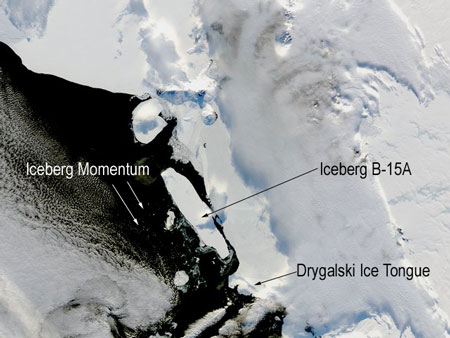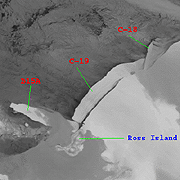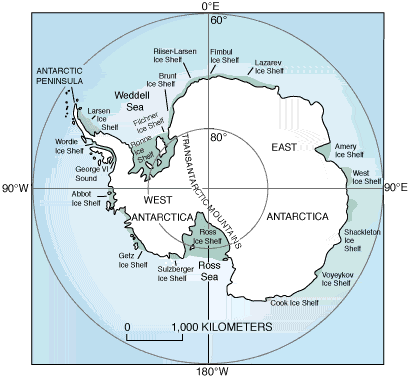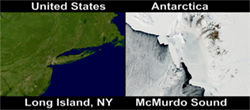|
ICEBERG GIANTS |
||
|
HOME SITE INDEX CATAMARAN HULL SOLAR PANELS ELECTRIC MOTORS BATTERIES CREW EXPEDITION SPONSORS |
||
|
Antarctica shed a 208-mile-long berg in 1956
One of the largest known Antarctic icebergs broke off in 1956. Julie Palis and Guy Guthridge of the Naitonal Science Foundation and Lyn Lay, the librarian at Byrd Polar Research Center, found an article about it in the Polar Times, vol. 43, page 18. Here is the entire text:
A record iceberg seen in Antarctic
"Little America V, Antarctica, Nov. 17- The U.S.S. Glacier, the Navy's most powerful icebreaker, has sighted an iceberg more than twice the size of Connecticut."
"The berg was sighted by the Glacier early this week about 150 miles west of Scott Island. The ship reported it was 60 miles wide and 208 miles long- or more than 12,000 square miles, as against Connecticut's 5,009."
"According to the United States Navy sailing directions for Antarctica, the largest berg hitherto reported was that seen Jan. 7, 1927, off Clarence Island by the Norwegian whale catcher Obb I. The ship said it was 130 feet high and roughly 100 miles long. Both these gargantuan icebergs were of the tabular variety typical of Antarctica. This type consists of a section of continental ice sheet that has pushed out a great distance over the sea before breaking off a situation that does not arise in the Arctic. The tabular berg has a flat top and is of uniform height, drawing roughly 700 feet of water."
"It was the "calving" that is, breaking off, of such an immense wafer of ice at the Bay of Whales sometime between 1948 and 1955 that deprived the original Little America of its harbor. Hence this camp, built early this year, had to be set up on Kainan Bay, thrity-five miles to the east."
124-mile-long iceberg breaks off Antarctica
An iceberg 124 miles long and more than 19 miles wide has broken off Antarctica's Ross Ice Shelf. The iceberg is the largest to break off Antarctica since a March 2002 berg that was 170 miles long and 25 miles wide.
Icebergs - B-15A, C-18 and C-19
Iceberg B-15A, which broke off in March 2000, sits at a right angle to C-19, which broke away from the Ross Ice Shelf last last week. C-18, which broke off earlier last week, is at the eastern end of C-19. The U.S. McMurdo Station is on Ross Island.
On Saturday the National Ice Center in Washington, D.C., confirmed the size and position of the new berg and labeled it "C-19" because it was the 19th iceberg to break off in its part of Antarctica since tracking began.
Antarctic icebergs are spotted and tracked with satellite photos. Linda Keller, a researcher at the University of Wisconsin at Madison, first noticed a crack separating C-19 from the rest of the Ross Ice Shelf last Friday while she was posting daily satellite images on the University's Antarctic Meteorology Research Center's Web site.
Keller notified the National Ice Center, which tracks Antarctic and Arctic icebergs. The iceberg was no surprise to Antarctic ice researchers. "The crack has been there about as long as people have been going to Antarctica," says Charles Stearns, an emeritus professor at the University of Wisconsin. "In 1987, I saw it from an icebreaker."
He says glaciers and ice streams carry ice from the high Antarctic plateau covering most of the continent, where it slowly moves down to the ice shelves at the edges of the continent. There it gradually sloughs off, or calves, in the form of icebergs. Stearns says the calving brings the Ross Ice Shelf to the about the size it was in 1911, when members of Robert Falcon Scott's British expedition first mapped it.
On May 9, the Ice Center reported that a 47-mile-long iceberg, which it named C-18, had broken from the Ross Ice Shelf at the eastern end of what became C-19. Ross icebergs such as C-19 and B-15 the 170-mile-long berg that broke off in 2000 tower about 100 feet, about as high as a 10-story building, above the Ross Sea. Another 900 feet of ice lies under the water.
Antarctica
In 2000, B-15 broke into two parts a few days after calving. These were named B-15A and B-15B. Now, B-15A is near the entrance to McMurdo Sound at the western end of C-19. Last year, B-15 acted like a huge breakwater that kept waves from the Ross Sea from entering McMurdo Sound. One result was that the sound's sea ice lasted longer than usual. Among other things, this kept many penguins from their normal ocean feeding grounds, and hundreds of birds died.
The unusually extensive and thick ice also led the National Science Foundation to ask the U.S. Coast Guard to send two instead of the usual one icebreakers to clear a path for supply ships to the U.S. McMurdo Station last December.
C-19 and the other large icebergs are much farther south in a colder part of Antarctica than the peninsula where part of the Larsen B Ice Shelf broke up earlier this year. While the peninsula is warming, temperatures in the rest of Antarctica seem to have held about the same since the 1960s, and some parts are turning colder.
Neither the breakup of the Larsen B Ice Shelf nor the melting of icebergs that break off Antarctic ice shelves causes sea levels to rise because the ice is already floating. Last month, Ted Scambos of the National Snow and Ice Data Center in Boulder, Colo., was asked: Does the disintegration of the Larsen B ice shelf show what's going to happen to the Ross Ice Shelf and Antarctica's other shelves?
Not anytime soon, he answered. "It would take a warming trend as extreme as the one in the Antarctic Peninsula for at least 50 years to bring the Ross Ice Shelf to the threshold" of breaking up. Still, he added, the Larsen B disintegration is "a great lab experiment. We're seeing something that doesn't have a lot of global consequences but serves as a glimpse of what's going to happen elsewhere in areas that do have a lot of global consequences in the future."
Get Ready for the Largest Demolition Derby on the Planet 01.06.05

Iceberg B-15A on collision course
|
||
|


